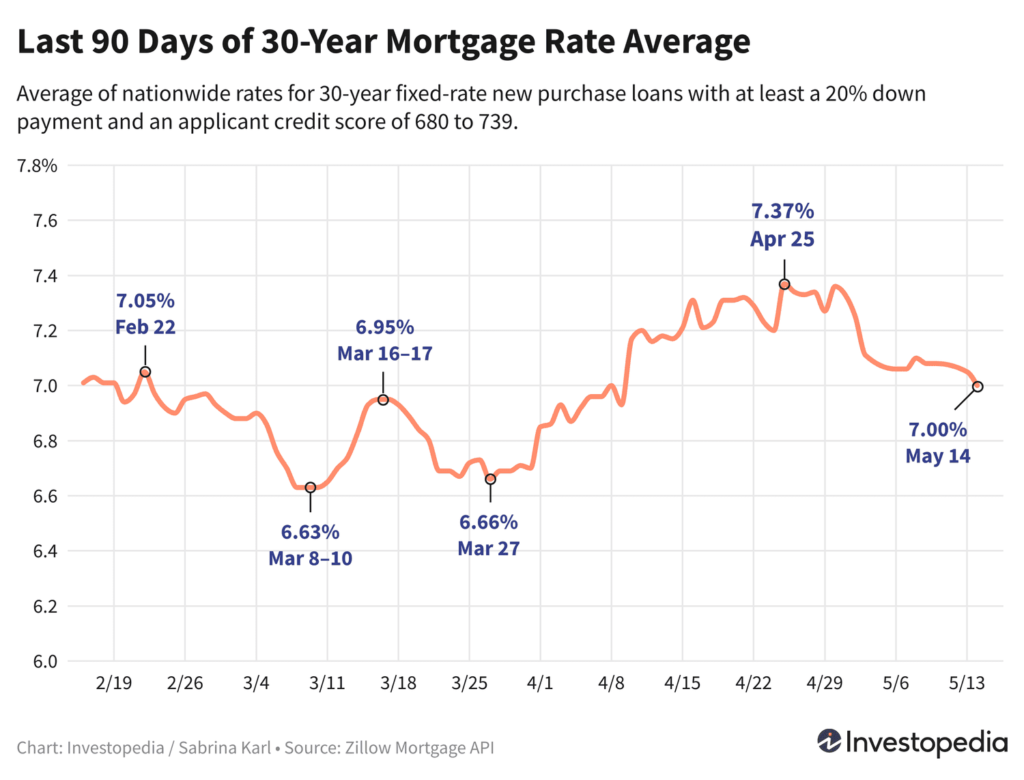| National Mortgage Rate Averages – Refinance Loans | ||
|---|---|---|
| Loan Type | Refinance Average | Daily Change |
| 30-Year Fixed | 7.41% | +0.01 |
| FHA 30-Year Fixed | 6.60% | No Change |
| VA 30-Year Fixed | 6.32% | -0.01 |
| 20-Year Fixed | 6.91% | -0.07 |
| 15-Year Fixed | 6.25% | -0.11 |
| FHA 15-Year Fixed | 6.33% | No Change |
| 10-Year Fixed | 6.12% | No Change |
| 7/6 ARM | 8.26% | -0.05 |
| 5/6 ARM | 8.30% | -0.04 |
| Jumbo 30-Year Fixed | 7.12% | +0.02 |
| Jumbo 15-Year Fixed | 7.36% | +0.21 |
| Jumbo 7/6 ARM | 8.03% | +0.05 |
| Jumbo 5/6 ARM | 8.07% | +0.01 |
| Provided via the Zillow Mortgage API | ||
Calculate monthly payments for different loan scenarios with our Mortgage Calculator.
The rates you see here generally won’t compare directly with teaser rates you see advertised online, since those rates are cherry-picked as the most attractive, while these rates are averages. Teaser rates may involve paying points in advance, or they may be based on a hypothetical borrower with an ultra-high credit score or for a smaller-than-typical loan. The mortgage rate you ultimately secure will be based on factors like your credit score, income, and more, so it can vary from the averages you see here.
Mortgage Rates by State
The lowest mortgage rates available vary depending on the state where originations occur. Mortgage rates can be influenced by state-level variations in credit score, average mortgage loan type, and size, in addition to individual lenders’ varying risk management strategies.
The states with the cheapest 30-year new purchase rates Tuesday were New York, Florida, Texas, Alaska, New Jersey, California, and Oregon, while the states with the highest average rates were West Virginia, Maryland, Washington, D.C., Alabama, Hawaii, Iowa, and Virginia.
What Causes Mortgage Rates to Rise or Fall?
Mortgage rates are determined by a complex interaction of macroeconomic and industry factors, such as:
Because fluctuations can be caused by any number of these at once, it’s generally difficult to attribute the change to any one factor.
Macroeconomic factors kept the mortgage market relatively low for much of 2021. In particular, the Federal Reserve had been buying billions of dollars of bonds in response to the pandemic’s economic pressures. This bond-buying policy is a major influencer of mortgage rates.
But starting in November 2021, the Fed began tapering its bond purchases downward, making sizable reductions each month until reaching net zero in March 2022.
Between that time and July 2023, the Fed aggressively raised the federal funds rate to fight decades-high inflation. While the fed funds rate can influence mortgage rates, it does not directly do so. In fact, the fed funds rate and mortgage rates can move in opposite directions.
But given the historic speed and magnitude of the Fed’s 2022 and 2023 rate increases—raising the benchmark rate 5.25 percentage points over 16 months—even the indirect influence of the fed funds rate has resulted in a dramatic upward impact on mortgage rates over the last two years.
The Fed has been maintaining the federal funds rate at its current level since July, with a sixth consecutive rate hold announced May 1. Although inflation has come down considerably, it is still above the Fed’s target level of 2%. Until the central bank feels confident inflation is falling sufficiently and sustainably, it has said it’s hesitant to start cutting rates.
The Fed will hold five more meetings this year, with the next one scheduled to conclude June 12.
How We Track Mortgage Rates
The national and state averages cited above are provided as is via the Zillow Mortgage API, assuming a loan-to-value (LTV) ratio of 80% (i.e., a down payment of at least 20%) and an applicant credit score in the 680–739 range. The resulting rates are representative of what customers should expect to see when receiving actual quotes from lenders based on their qualifications, which may vary from advertised teaser rates. © Zillow, Inc., 2024. Use is subject to the Zillow Terms of Use.

